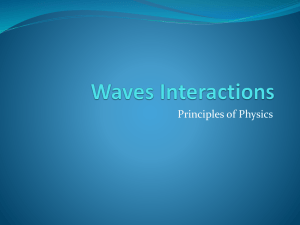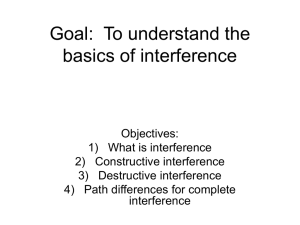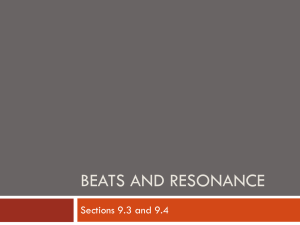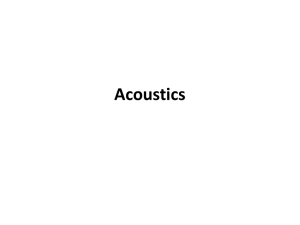waves_02
advertisement
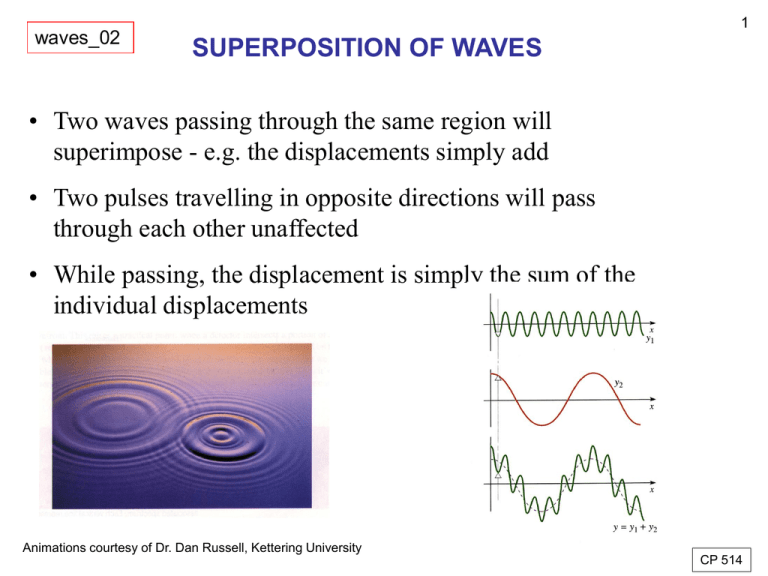
waves_02 1 SUPERPOSITION OF WAVES • Two waves passing through the same region will superimpose - e.g. the displacements simply add • Two pulses travelling in opposite directions will pass through each other unaffected • While passing, the displacement is simply the sum of the individual displacements Animations courtesy of Dr. Dan Russell, Kettering University CP 514 2 waves_02: MINDMAP SUMMARY – SUPERPOSITION PRINCIPLE Travelling waves, superposition principle, interference, constructive interference, destructive interference, intermediate interference, nodes, antinodes, phase, phase difference, in phase, out of phase, path difference, two point interference, standing waves on strings, standing waves in air columns, thin film interference Superposition (at time to) Wave 1 + Wave 2 14 15 y ( x, to ) y1 ( x, to ) y2 ( x, to ) Constructive interference: = m = m (2) Destructive interference: = (m + 1/2) = (m + ½) (2) m = 0, 1, 2, 3, ... SUPERPOSITION INTERFERENCE 3 28 24 20 16 12 8 In phase constructive interference 4 Out of phase destructive interference 0 0 10 20 30 40 50 60 70 80 90 CP 510 4 Problem 1 Two sine waves travelling in the same direction Constructive and Destructive Interference Two sine waves travelling in opposite directions standing wave 5 Interference of two overlapping travelling waves depends on: * relative phases of the two waves * relative amplitudes of the two waves fully constructive interference: if each wave reaches a max at the same time, waves are in phase (phase difference between waves two waves = 0) greatest possible amplitude ( ymax1 + ymax2) fully destructive interference: one wave reaches a max and the other a min at the same time, waves are out phase (phase difference between two waves = rad), lowest possible amplitude |ymax1 - ymax2| 0 < phase difference < rad or < phase difference < 2 intermediate interference: SUPERPOSITION INTERFERENCE A phase difference of 2 rad corresponds to a shift of one wavelength between two waves. For m = 0, 1, 2, 3 fully constructive interference phase difference = m fully destructive interference phase difference = (m + ½) 6 7 SUPERPOSITION INTERFERENCE 60 60 50 50 40 40 30 30 20 20 10 10 0 0 0 100 200 300 400 500 600 700 800 0 100 200 300 400 position 500 600 700 800 position A B 60 50 40 30 Which graph corresponds to constructive, destructive and intermediate interference ? 20 10 0 0 100 200 300 400 500 position C 600 700 800 SUPERPOSITION INTERFERENCE What do these pictures tell you ? 16 17 18 19 20 21 8 9 CONSTRUCTIVE INTERFERENCE path length difference = 2 phase difference = 2 (2 ) = 4 10 DESTRUCTIVE INTERFERENCE path length difference = 3 ( / 2) phase difference = 3 11 PARTIAL INTERFERENCE Problem solving strategy: I S E E Identity: 12 What is the question asking (target variables) ? What type of problem, relevant concepts, approach ? Set up: Diagrams Equations Data (units) Physical principals PRACTICE ONLY MAKES PERMANENT Execute: Answer question Rearrange equations then substitute numbers Evaluate: Check your answer – look at limiting cases sensible ? units ? significant figures ? SUPERPOSITION INTERFERENCE 13 In phase Audio oscillator s2 s1 Out of phase Path difference = |s2 - s1| Phase difference = 2 ( / ) CP 523 14 Problem 2 Two small loudspeakers emit pure sinusoidal waves that are in phase. (a) What frequencies does a loud sound occur at a point P? (b) What frequencies will the sound be very soft? (vsound = 344 m.s-1). 2.00 m 3.50 m P 2.50 m CP 523 Solution 2 s2 2.52 3.52 4.30 m s1 2.02 3.52 4.03 m Construction interference v = s2 -s1 m m f mv f m 0,1,2,... = s2 -s1 4.30 4.03 m=0.27 m 344 f m 1274 m 0.27 1.27 kHz, 2.55 kHz, 3.82 kHz, … , 19.1 kHz Destructive interference (m 2 ) v 1 1 = s2 -s1 (m 2) (m 2) f f 1 344 1 1 f m 2 1274 m 2 0.27 m 0,1,2,... 0.63 kHz, 1.91 kHz, 3.19 kHz,… , 19.7 kHz Problem 3 Two speakers placed 3.00 m apart are driven by the same oscillator. A listener is originally at Point O, which is located 8.00 m from the center of the line connecting the two speakers. The listener then walks to point P, which is a perpendicular distance 0.350 m from O, before reaching the first minimum in sound intensity. What is the frequency of the oscillator? Take speed of sound in air to be 343 m.s-1. r1 (8.00) 2 (1.15) 2 m 8.08 m r2 (8.00)2 (1.85) 2 m 8.21 m 1 r2 r1 (n ) and n 0 2 2(r2 r1 ) 0.26 m f v 343 Hz 1.3 103 Hz 0.26 17 FOURIER ANALYSIS • A sinusoidal sound wave of frequency f is a pure tone • A note played by an instrument is not a pure tone - its wavefunction is not of sinusoidal form • The wavefunction is a superposition (sum) of a sinusoidal wavefunction at f (fundamental or 1st harmonic), plus one at 2f (second harmonic or 1st overtone) plus one at 3f (third harmonic or second overtone) etc, with progressively decreasing amplitudes • The harmonic waves with different frequencies which sum to the final wave are called a Fourier series. Breaking up the original wave into its sinusoidal components is called Fourier analysis. CP 521 Superimpose resultant (add) waveform 18 Waveform Fundamental 1st harmonic 1st overtone 2nd harmonic 2nd overtone 3rd harmonic CP 521 FOURIER ANALYSIS any wave pattern can be decomposed into a superposition of appropriate sinusoidal waves. 19 FOURIER SYNTHESIS any wave pattern can be constructed as a superposition of appropriate sinusoidal waves An = A1 / n fn = n f1 Electronic Music ??? n y An sin(2 f n ) n 1 CP 521 Quality of Sound Timbre or tone color or tone quality http://paws.kettering.edu/~drussell/Demos/ superposition/superposition.html Frequency spectrum noise music piano Harmonics piano Harmonics Some of the animations are from the web site http://paws.kettering.edu/~drussell/demos.html The Physics Teacher Vol 33, Feb 1995 INTERFERENCE PATTERNS AND LANDING AIRCRAFT Aircraft are guided in landing with the aid of the interference pattern from two aerials A1 and A2 about 40 m apart. The aerials emit coherent waves at 30 MHz. The wavelength is = c / f = 10 m . The lines of maximum signal strength are shown in the diagram. The number of lines emanating between the aerials depends upon the wavelength and the distance between the aerials such that centre line corresponds to the central maximum. The plane should fly along the line of the central maximum. If a plane flies along an adjacent (weaker) line of maximum signal strength, the planes position can be in error by about 500 m. Aerials are also placed so a vertical interference pattern is set up so that the height of the plane can be controlled to fly along this central maximum. 22


